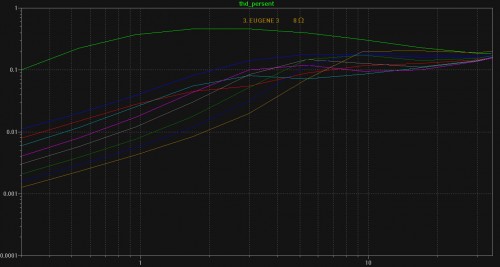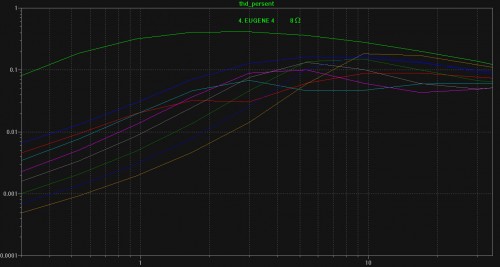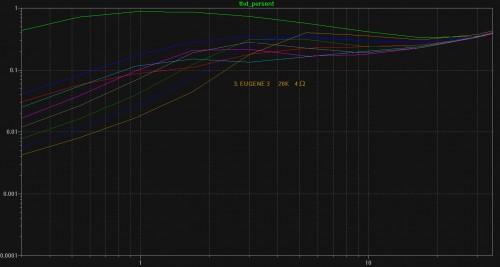Output Stage
Total Harmonic Distortion performance at 20 KHz.
Next step is to test performance of all stages at higher frequencies. All tests are performed in the same manner as in previous testing. Inputs of all 4 stages are connected together and transfer function of every stage is modified to have Gain=1 with corresponding loads and at 20 KHz.
BIOS optimization at higher frequencies.
Optimum bias settings, corresponding to minimum distortions may be frequency dependent. Let’s have a look at THD performance with different bias settings at 20 KHz.
I used 20mA, 40mA, 60mA, 80mA, 110mA, 140mA, 190mA, 240mA and 300mA quiescent currents. Color legend for used BIAS is represented by the following picture:

BIAS COLOR LEGEND
20 KHz, 8 Ohm results:

Stage 1, THD vs Amplitude, different BIASes, 20 KHz, 8Ohm

Stage 2, THD vs Amplitude, different BIASes, 20 KHz, 8Ohm

Stage 3, THD vs Amplitude, different BIASes, 20 KHz, 8Ohm

Stage 4, THD vs Amplitude, different BIASes, 20 KHz, 8Ohm
20 KHz, 4 Ohm results:

Stage 1, THD vs Amplitude, different BIASes, 20 KHz, 4Ohm

Stage 2, THD vs Amplitude, different BIASes, 20 KHz, 4Ohm

Stage 3, THD vs Amplitude, different BIASes, 20 KHz, 4Ohm

Stage 4, THD vs Amplitude, different BIASes, 20KHz, 4Ohm
Based on these test results we may consider the following optimal quiescent currents:
- Stage 1: 60-80 mA;
- Stage 2: 60-80 mA;
- Stage 3: 60-80 mA;
- Stage 4: 60-80 mA.
You may also see that optimum values for stage 3 are different on 20 KHz, compared to 1 KHz.
For all other stages they are approximately the same.
THD of all stages after optimization, 20 KHz, 8 Ohm:

THD of all stages after optimization, 20 KHz, 8 Ohm
THD of all stages after optimization, 20 KHz, 4 Ohm:

THD of all stages after optimization, 20 KHz, 4 Ohm
Table of content:
Comments
Pingback: Total Harmonic Distortion tests and results | Audio Perfection
Pingback: In the search of “Holy Grail” of output stages, evaluating performance of Power Amplifier output stages for High-End applications | Audio Perfection